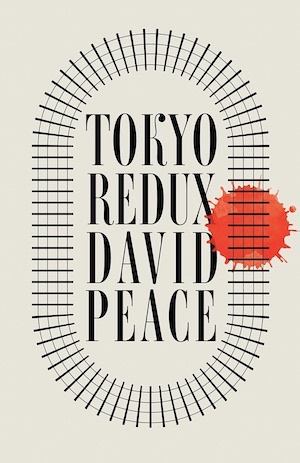
It’s been almost 12 years since Occupied City, the second instalment in David Peace’s Tokyo trilogy, was published. For fans of this ambitious author it’s been a long wait, but in Tokyo Redux Peace delivers a humdinger which, according to the author, was in part delayed by the sheer volume of material about the case it’s based on.
That case is referred to in Japan as the ‘Shimoyama incident’ – the death of Shimoyama Sadanori, the first president of Japanese National Railways (JNR). After 70 years it remains unsolved and is firmly embedded in Japanese culture much like the JFK assassination or the murder of Sweden’s prime minister, Olaf Palme. All three incidents had a similar impact on their nation’s psyche and generated conspiracy theories resulting in multiple books, articles and films.
Tokyo Redux is split into three sections which span four decades, from 1949 to 1988. In the first, set in July 1949, Shimoyama Sadanori, head of JNR is reported missing by his colleagues after failing to attend an important meeting. Witnesses report seeing someone fitting his description at a department store and riding a subway train and he is subsequently believed to have disappeared on his way to work.
Enter Harry Sweeney, a police investigator for the American Public Safety Division, based on the real person charged by the Occupation to investigate Shimoyama’s disappearance. Sweeney is described as the ‘Eliot Ness of Japan’, a conscientious, diligent, yet jaded detective who takes his work seriously and channels the stereotypical hardboiled American detective through his words and actions.
Sweeney has barely kicked off his investigation when Shimoyama’s body is found, mangled and partly dismembered, at a spot known as Demon’s Crossing, notorious for accidents and suicides. Witnesses report seeing a man resembling Shimoyama in the area where the body was found. The immediate assumption is that he committed suicide, but would a man who loved trains use them as a tool to end his life? Shimoyama was under pressure at work after authorising a mass retrenchment leading to 30,000 workers losing their jobs, and had been repeatedly threatened by the National Railroad Workers’ Union. An insomniac, he was also taking sleeping pills which might have impaired his judgement or altered his emotional state.
Through the witness statements Sweeney traces the whereabouts of Shimoyama on the day before he was found dead, but something doesn’t add up. Was it a murder or a suicide? Unfortunately we are left with no answers.
From an unresolved first section we travel to Tokyo in 1964 during the Olympics. A character from Tokyo Zero, former cop Murota Hideki returns and is now a private investigator hired by a publishing house to find Kuroda Roman. The mystery writer has been missing for six months and owes his publishers a completed manuscript on the Shimoyama murders or he must pay back his substantial advance. Kuroda became obsessed with solving the case and writing about it to such an extent that he ended up in a mental institution. According to the statute of limitations, 1964 is also the year when the case will be officially closed, putting even more pressure on solving it.
The last section of this sweeping epic has yet another protagonist, American translator, Donald Reichenbach who works for the state department. It’s 1988 and Emperor Showa, who led Japan through World War II, is dying. Apart from worrying about his own mortality, 74-year-old Reichenbach meets Julia Reeve, a young woman who brings back ghosts from Reichenbach’s life in Tokyo during the Occupation.
As with the two previous novels in the trilogy, Tokyo Redux is plotted around real occurrences from the post-war era in Tokyo. Tokyo Zero has Murota Hideki investigating Yoshio Kodaira, a serial killer and rapist who murdered at least eight people in the Tokyo and Tochigi Prefecture areas between 1932 and 1946. Occupied City dealt with the case of Hirasawa Sadamichi, convicted of mass poisoning, told from the perspective of 12 narrators. Apart from their real-life connection, all three novels have the US Occupation of Japan as a thread running through them.
If you think this sounds like a considerable amount of historical information, you would be correct. Tokyo Redux on its own, disregarding the previous books, is a substantial piece of work. This isn’t light reading. The combination of three timelines, three protagonists, an unresolved death and a challenging writing style makes for a sometimes frustrating read.
In style there are elements of hardboiled detective fiction, especially in the first section when the reader is transported into Sweeney’s head through the continuous repetition of his activities. Every observation is meticulously recorded and readers are given a blow-by-blow account of his actions, movements and observations down to the smallest detail. This is Peace’s style, but it can be infuriatingly repetitive to the point of off-putting. Long, repetitive sentences are intentionally used, whether to create a feeling of confusion, restlessness or merely indicating monotony in the characters’ daily routine. It might be an attempt to create a meditative rhythm, but it has the opposite effect; it breaks the flow, delays the storyline and adds padding where bare bones might have sufficed.
Melancholy seeps through the pages like a wet and dreary noir night. It’s grim, dark and moody with no positive outcomes.
Of course, good literature doesn’t necessarily equate to easy reading and Tokyo Redux certainly falls at the literary end of the fiction spectrum. Peace attempts to write the anti-crime novel, using crime fiction tropes, but then subverting them thereby not sensationalising crime. Instead he portrays real crimes and their lasting repercussions. As in real life, everything isn’t neatly packaged and resolved on the last page. This is certainly the case with Tokyo Redux. The only question remaining is if you’re up for a dose of hard-hitting historical fiction based on reality.
See these 10 literary classics which are also crime stories.
Faber
Print/Kindle/iBook
£16.99
CFL Rating: 3 Stars









